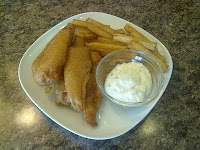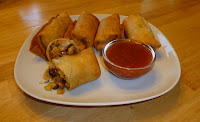I've always liked seafood, but after living in Seattle for a couple of years, a desire for really great seafood becomes ingrained in your soul.
Whenever you live near the sea, you can find great seafood and Seattle is no different. I mean, Seattle is world renown for some of the greatest fish, and of course the most inventive way to package it. I've seen the fishthrowers myself. I've caught a fish from the fishthrowers. It was awesome! But as much fun that was, the fish was just as delicious.
And if you don't want to cook it yourself, there are dozens of places that serve up delicious seafood all over the metro area. There's
Chinooks at Salmon Bay. It's about a ten minute drive northwest of downtown Seattle on your way to the Crittenden Locks. You'll eat exquisite seafood while peering out at the fishing boats that caught the fish moored just outside. I was lucky enough to have a little hole in the wall seafood fry house up in Bothell when I lived in the north end. I forget the name, but they had a fisherman's platter of all sorts of fried seafood: cod or halibut, shrimp, scallops, clams, and calamari. I'd skip lunch altogether so I could have a chance of devouring all this monstrosity on the way home.
Then there's the
Athenian Restaurant and Bar located just north of the fishthrowers in Pike Place Market. The food is great, but the view is better. Go up the stairs to the top and you'll have possibly the best view of the Puget Sound in town. You'll be just above the rest of the market and high enough so the Alaska Highway doesn't obstruct your sightlines. On sunny spring and summer days, which aren't as rare as you'd think they would be, you can see all the way across to Bremerton, and then see the towering Olympics behind them. If you ever make it there, sit in these seats. And if you're lucky, the windows will be open slightly. That way, you'll have the occasional seagull land on the perch and beg for your fries.
Now that I'm landlocked in Salt Lake, we still have a few good seafood restaurants. If I had to choose one, I'd choose Market Street, because they do fly some of their seafood in same day. It's fresh and delicious, and you will pay a pretty penny for it.
But there are times that I want a large seafood fry and I've found that I can make it at home for about half the price. We've already talked about
frying shrimp. But lets talk about frying us up some fresh fish. Now you can use any type of fish you can get your hands on. I really like the firmness and taste of cod. Halibut is absolutely heavenly when it's fried. But both of these can be pricey. Catfish can be great as well, and it'll make you think more of the deep south. But if you're looking for an inexpensive option, tilapia is tasty, and can be found for about $5-6 a pound at the butcher block.
No matter what you choose, MAKE SURE it's boneless. Nothing's worse than finding a small, spindly bone stabbing into your upper palette.
Now we've talked about dredging food through an egg wash and some other type of starch to get a great coating for deep frying. But for this food, we need to create a batter like we did for our
Orange Chicken. It's the same portions as before: 1/2 cup starch, 1/2 liquid and one egg. But we have some specific changes. First, your liquid is beer. It can be any type of beer, but remember the cardinal rule about cooking with alcohol, "Never use any alcohol that you wouldn't drink by yourself". It's not worth using the cheap stuff like Pabst Blue Ribbon, unless you really like it. And don't worry about the alcohol, it will cook out. Also, this recipe has one other ingredient. We add a little baking powder to the batter so it will come out puffy and slightly craggy, creating extra pockets so you'll collect a little more tartar sauce when you dip.
And what goes better with fried fish than some fresh french fries. Now the fries I make with the fish are cooked twice. This way they don't get too dark, and they are cooked thoroughly. Sometimes, raw potatoes that are freshly fried can scorch before the centers are cooked through. So I cook them for four minutes, remove them from the oil, pat them dry, and cook them again about 5 minutes later. That little rest allows the heat to penetrate into the center of the fries. This way, the fries are crispy on the outside, but warm, fully cooked and squishy on the inside.
One last tip for the fries... Uniformity is key. You can cut the fries into any shape, but they should all be the same shape with the same width, height and depth. If they're different sizes, some will burn before the others are done. I was given a potato slicer for my wedding and I use this when I make fries. You can do this, or you can use a mandolin or food processor to cut them into uniform bits. You can even cut them by hand, but try your best to make them all the same size.
Fish and Chips
Serves 3-4
Fried Fish
Bottle of canola or vegetable oil
1 pound fresh fish (halibut, cod, tilapia or catfish preferred)
1 cup flour
1 cup beer (your favorite type)
1 teaspoon baking powder
2 eggs
Pour the flour and baking powder into a bowl and whisk to combine. Add the beer and the eggs and whisk it again until it's well blended. Place it in the fridge and allow it to chill while the oil heats up.
Pour enough oil into a large saucepan or saute pan to come 2-2 1/2 inches up the sides. Begin heating the oil, but do not let it go over 340 degrees.
Slice the fish filets into long thick strips and rinse with water. Once the oil has reached at least 330 degrees, using a set of tongs, dip a filet into the batter and then directly lay it into the oil. Repeat, but do not add too many filets to crowd the pan. Cook for 4 minutes or until the exterior is a deep golden brown. Remove the fish to a cooling rack with some paper towels beneath to collect any dripping oil. Continue until all of the fish is cooked.
If you want to keep them hot while the other items cook, place them into a 200-225 degree oven.
Now either you can cook the fries in another pan or in the same pan before or after you cook the fish. Either works great.
French Fries
Cooking Oil
1 to 1 1/2 pounds russet potatoes
Heat 2 inches deep of oil in a saucepan or a saute pan to 330 degrees. Slice the potatoes into uniformed bits, preferably around 1/4-1/2 inch thick. You can use a potato slicer, mandolin, food processor or a knife, your choice. Pad them with a paper towel to remove as much moisture as you can. Next, add enough of the fries to the oil to not crowd the pan and let them cook for 4-5 minutes. After 4-5 minutes, remove them to a cooling tray and add another batch to the oil. Pad all of the oil off of the first batch of fries and let them sit until the second batch has had it's first dip in the oil. After removing the second batch from the oil, put the first batch back into the oil and cook them for another 4-5 minutes. When you remove this batch, leave them on the cooling rack and let the second batch cook for another 4-5 minutes.
If you have more to cook and you want to keep them warm, move the cooling rack to a 200-225 degree oven until all are cooked.
Place portions of fish and fries on each plate and garnish with tartar sauce and ketchup.
So cook up a steaming pile of fried fish goodness to curb your craving for seafood. And try the tartar sauce on the fries, it's what the Seattlites do.





















